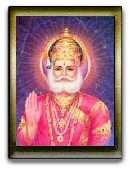| Maharaja Agrasen |
The
Messenger of Peace, Emperor
Maharaja Agrasen was born to King Ballabh of Pratapnagar.
According to current calendar the birth of Maharaja Agrasen
took place about 5000 years ago. King Ballabh was a
Suryavamshi ( lineage from the Sun). He was the eldest son .
According to the Mahalakshmi Vrath, the age then was the last
stages of Dvaapar Yug. Agroha / Agra Republic was established
around 51 years before the war of Mahabarat. According to
writers of (1) Bhavishya Puran Ke Agravansh , (2)
Vanishanukirtnam and (3) Uru Charitam Maharaja Agrasen ruled
some 5000 years back over Agroha around the time of
Mahabharat. This belief is testified by the mention of the
republican state of Agrayan in a couplet shloka of the great
epic Mahabharata . Even when he was very young , Prince
Agrasen was very well known for his compassion . He never
discriminated against anyone and the subjects were very
pleased with the way he conducted himself.
|
| | Top |
| Agroha |
Agroha,
located
about 20 Km's North-West of the City of
Hissar in the State of Haryana in India, was
once a very prosperous city . However , it has changed a lot
due to the ravages of time. Present day Agroha village is about
2.5 Km. from the old Agroha City . Agroha was the Republican
State consisting of 18 state units. The residents of
these states were known as Yodhya and Agraya. Some of the
writings on the coins that have been
excavated from the site of ancient
Agroha are (1)Yodhyanam Bahu
Dhanya Kanam (2) Yodhya Ganasya Jaya
(3)Yodhyanam Jaimantra Shalinam.The Agroha republic was renowned for its bravery and prosperity. However over the time it could not stand the foreign invasions of Hunas, Greeks and Yavanas, who invaded the north India disintegrating various kingdoms in Punjab . The disintegrated Agroha led to the migration of the residents of Agroha to other parts of the country viz. Rajasthan, Uttar Pradesh, Punjab and Malwa, however they derived a common name Aggarwals i.e.Agroha-Wale. |
| | Top |
| Experts Opinion About Origin Of Agroha |
- Dr. Satyaketu
Vidyalankar has written that Agroha existed some 100 Years before the kushan dynasty.
- Moshio Prajluski has in his writings
identified Agroha as Agrodak or Agrod
. This statement has been further testified by the writings on coins found from Agroha wherein Agrod or Agacha state has been written in the Brahm Lipi (script).
- Tolmy , a Greek writer in his book
titled Example of Geography has mentioned
about a city called Agara. This has been
equated to Agrohe by the geologist Rannal.
In the map supplemented in the book of Tolmy Agara has been
shown at the same place as the present Agroha
.
- According to the Punjab
Govt. Gazzette Agroha was a very big ancient city
. The primary efforts to discover its historical past were
made in the year 1888-89.
|
| | Top |
| First Efforts at Modernisation |
Businessmen
Seth Bholaram Dalmiya and Lala Samval Ram established a
Goshalain 1914 and Shree Ramjidas Bajoriya of Calcutta
built the Temple dedicated to Agrasen and established a
Dharmashala ( a place for poor people) in 1939.In April, 1975,
a All India Aggarwal Convention (Akhila Bharatiya Aggarwal
Sammelan) was held in New Delhi. At this convention a plan was
adopted for the development of Agroha . In 1976 , the
Agroha Vikas Trust was established. |
| | Top |
| Expansion of the Agroha Vikas Trust |
The
Aggarwal Engineering and Technical Society
gave 23 acres of land to the Agrawal Vikas
Trust. Through the effort of the Convention Director
Shri. Shrikishan Modi, the work on the Agrasen Temple
was started. In May, 1982, the sanctum of the Temple was
completed. The Akhila Bharatiya Aggarwal Sammelan
opened the Temple by organising the first Aggarwal
Kumbha Mela. It was a historic occasion where more than 50,000
people of the Aggarwal parivaar participated. A 300 x 400 feet
Tank called Shakti Sarovar was constructed by Sharad
Purnima in 1986. A beautiful image of Samudra Manthan
was installed in the middle of Shakti Sarovar. |
| | Top |
| Concept Of Gotras |
Maharaj
Agrasen established the republican state of Agroha. Agroha
consisted of 18 state units. The head of each state unit was
given a Gotra. All the residents of that particular state unit
were identified by that Gotra. It was maintained by Maharaj
Agrasen that a nupital alliance could not take place in the
same Gotra. That is a girl of Goel Gotra could not marry a
Goel Gotra boy , but could be married in any of the other 17
Gotra. This rule enunciated by Maharaj Agrasen promoted
harmony and brotherhood among all the 18 Gotra represented by
state units. This facilitated promotion of unity and
nationalism among the state units. |
| | Top |
| Agrawal Gotra |
Garg,
Mangal, Kucchal, Goyan, Goyal, Bansal, Kansal, Singhal,
Jindal, Thingal, Airan, Dharan, Madhukul, Bindal, Mittal,
Tayal, Bhandal, Naagal. |
| | Top |
|
|
|


